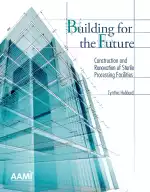Building for the Future Construction and Renovation of Sterile Processing Facilities PDF Download
Book EN Sample 1 Sample 2Also Known As:
Introduction
The healthcare delivery system in the United States is in transition again because of technology advances, the impact of healthcare reform on the growth of outpatient care, and the push toward more cost-effective inpatient care.
In response to public awareness and a growing concern for patient safety, organizations are looking for ways to reduce waste and improve efficiency by streamlining processes and operations.
Additionally, there is a need to ensure a consistently high level of quality in activities that put patients at risk for healthcare-associated infections (HAIs).
Because medical device reprocessing activities, especially those concerning decontamination and sterilization in hospitals, are vital infection prevention components, they are subject to continual scrutiny.
In cases of a system failure or a patient incident, the first step taken to prevent a recurrence and improve sterile processing consistency is generally to focus on procedures and processes.
By reviewing current practice and comparing it with the recommendations of groups such as The Joint Commission (TJC), the Centers for Disease Control and Prevention (CDC), state health departments, the Centers for Medicare and Medicaid Services (CMS), and professional organizations such as the Association of periOperative Registered Nurses (AORN), the International Association of Healthcare Central Service Materiel Management (IAHCSMM), the Association for Professionals in Infection Control and Epidemiology (APIC), and the Association for the Advancement of Medical Instrumentation (AAMI), managers can learn what constitutes best practices.
By implementing procedural and process improvements based on best practices, much can be done to create both a climate and activities that foster consistent quality.
In many circumstances, however, the approach needed to create an environment supportive of improved quality involves not only cultural or procedural changes, but also some level of physical remodeling or even new construction.
Historically, sterile processing areas have been designed and constructed for long-term use, and renovation or new construction occurs only when there is obsolete equipment to be replaced or the healthcare facility itself is planning new construction related to the support of surgical patients.
As a result, sterile processing, perioperative services, and facility managers—and even hospital administrators—seldom have experience in planning and managing construction-related projects in reprocessing areas and feel unprepared for the process.
The purpose of this manual is to assist everyone concerned with the quality of design in healthcare sterile processing departments (SPDs) by providing guidelines for planning and managing construction.
Project managers, sterile processing professionals, perioperative services managers, facility managers, hospital administrators, and new members of the healthcare design community will find useful information here.
The manual covers three main topics: new construction, renovation, and equipment planning.
| Language(s) | English |
| File Size | 4.0 MB |


